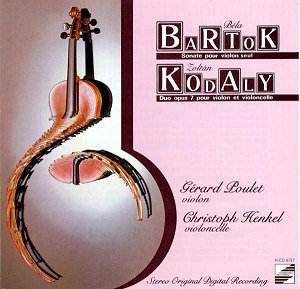|
|
Search MusicWeb Here |
|
 |
||
|
Founder:
Len Mullenger (1942-2025) Editor
in Chief:John Quinn
|
|
|
Search MusicWeb Here |
|
 |
||
|
Founder:
Len Mullenger (1942-2025) Editor
in Chief:John Quinn
|
 |
Belá BARTÓK (1881 - 1945)
Sonata for Solo Violin Zoltán KODÁLY (1882 - 1967) Duo Op. 7 Recorded at Chateau de Ripaille, Thonon des Bains, Haute-Savoie, France on May 14th-17th, 1987 |
| CD available for post-free online mail-order or you may download individual tracks. For some labels you can download the entire CD with a single click and make HUGE savings. The price you see is the price you pay! The full booklet notes are available on-line. | |
|
NOTE • Click on the button and you can buy the disc or read the booklet details • You can also access each track which you may then sample or down load. • Further Information. |
|
|
This is an inspired coupling of two masterpieces for strings. The playing time may indeed be low (47 minutes), but the sheer concentration of ideas (and the reciprocal response from Poulet and Henschel) make for a powerful listening experience. Belonging to Bartók’s final period (commissioned by Yehudi Menuhin in 1943 and composed in 1944), the Sonata for Solo Violin is a masterpiece, and Poulet plays it as such. There is a gritty determination to his playing which suits the piece, complemented with an almost exquisite lyricism: listen to the way he spins a line in the first movement (7’30-45), and contrast this with the ‘buzzing’ finale. Poulet has a sweet tone that is heard to best effect in the third movement, ‘Melodia’. He also possesses an inspiring command of his instrument which means the listener can concentrate on Bartók’s musical processes. The disc is worth the price for this performance alone. Zoltán Kodály’s Duo, Op. 7, dates from 1914. Poulet is joined by the cellist, Christoph Henkel (whose instrument apparently at one time belonged to John Barbirolli). The opening movement brings out the best in both players (Poulet is exquisitely toned at 6’30, Henkel’s rich tone complementing him excellently. Poulet and Henkel create palpable tension in the slow movement, as the composer creates large, desolate pitch spaces between the instruments. The recording, which dates from May 1987, is exemplary. To reiterate: do not be put off by the low playing time: there are rich rewards here. Colin Clarke
|
| ADDITIONAL INFORMATION •
You can sample only 30 seconds (or 15% if that is longer) of a given track. Select from the View tracks list. Each sample will normally start from the beginning but you can drag the slider to any position before pressing play. • PLEASE NOTE: If you are behind a firewall and the sound is prematurely terminated you may need to register Ludwig as a trusted source with your firewall software.
•You will need Quicktime to hear sound samples. Get a free Quicktime download here • If you cannot see the "Sample All Tracks" button you need to download Flash from here.
|
|
|
Return to Index |